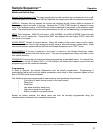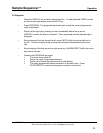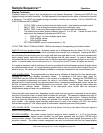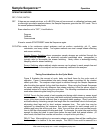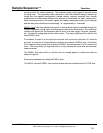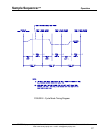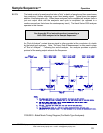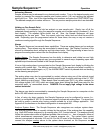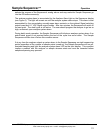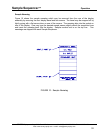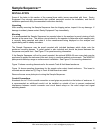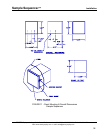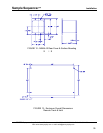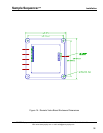
Sample Sequencer
Operation
Timing Considerations for the Batch Mode:
Figure 9 illustrates the concept of cycle, delay and dwell times for the batch mode of operation.
Figure 9 demonstrates how each sample stream is switched when the analyzer outputs an "end-
of-analysis" signal to the Sample Sequencer. If the Sample Sequencer doesn't receive an end-of-
analysis before the cycle time expires, the Sequencer goes into the off mode and the analyzer
alarm light on the front display goes on. Upon receiving an end-of-analysis signal from the
analyzer, the Sample Sequencer switches the analyzer output signal for the previous sample point
after the delay time period for a period of time equal to the dwell time. Note: The delay and dwell
time point numbers always lag the cycle time point number by one because it is a batch process.
Note: If using a Hach analyzer, see Appendix D.
The following considerations should be made when determining the timing for your batch mode
system:
End-of-Analysis
(or End-of-Measurement). This signal is received by the Sample Sequencer
(at terminals J4-3 and J4-4 on the I/O board) when the analysis is completed and the analyzer
is ready to output the results and is available to begin a new analysis.
CYCLE TIME
. The cycle time period in batch mode is an alarm condition such that if an end-
of-analysis signal has not been received before cycle time counts down to zero, something is
wrong with the analyzer and any further processing is impossible. Upon cycle time expiring,
the ANALYZER ALARM light on the Sample Sequencer display is initiated and the unit goes
into the "OFF" mode. The cycle time should be set at a value greater than the analyzer batch
process time.
DELAY TIME
begins when the end-of-analysis signal is received and until valid outputs from
the analyzer are available. One second plus any programmed delay time will elapse before
the Sample Sequencer looks at the analyzer output signals. Set the delay time for the amount
of time it takes the analyzer to output a new signal after it has issued an end-of-analysis.
DWELL TIME
. During the dwell time the Sequencer reads in the analysis value, saves it and
communicates as determined by output options and/or the value is communicated to a
computer, recorder, data logger, etc. The DWELL time must be long enough to satisfy the
output devices, (i.e., recorder computer, etc.), requirements. The sum of delay and dwell
times must be less than the analyzer end-of-analysis signal time period.
Turning Sample Streams On and Off
Sample streams may be removed from switching by turning the appropriate sample point number
off; streams may be turned on by turning the point number on. See the section in this manual
titled Membrane Switch Keys [sample point numbers (1-8)] for information about turning streams
on or off from the Sample Sequencer display. The points may also be controlled via a computer
using the built-in RS-485 network communications. See Communications section for more
information.
If the Sample Sequencer is currently on a sample point which you turn off, the point will complete
the entire cycle (including delay and dwell) and then be skipped on the next sequence occurrence.
If you wish to move on to the next point immediately, press the START/RESET switch on the front
display.
SENTRY Equipment Corp • P. O. Box 127 • Oconomowoc, WI 53066 • 262/567-7256 • FAX: 262/567-4523
Web: www.sentry-equip.com • e-mail: sales@sentry-equip.com
29



